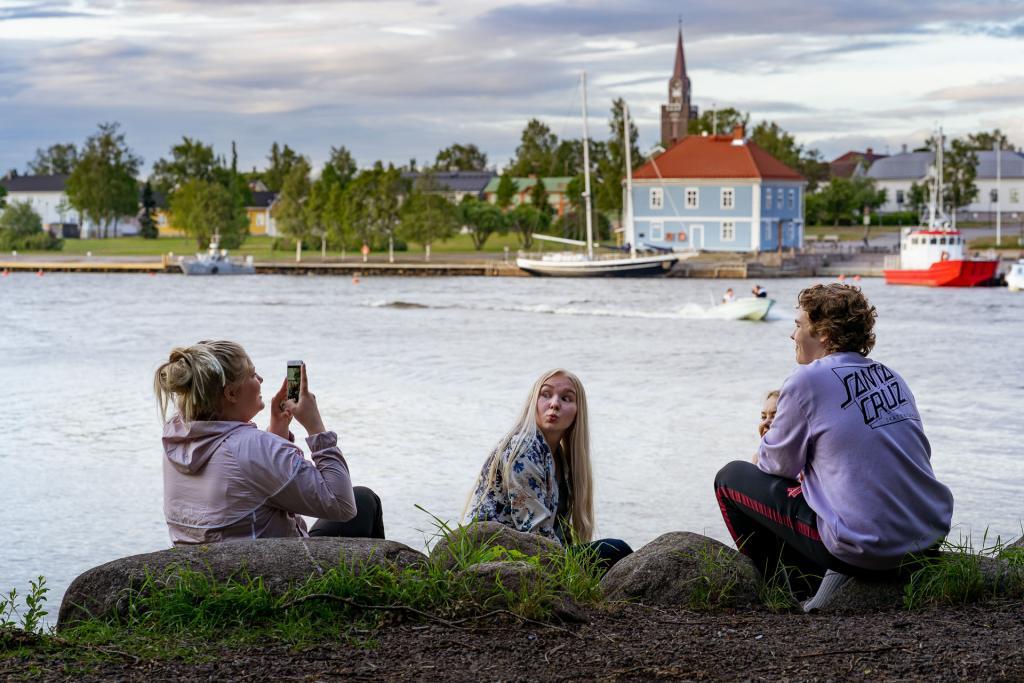Raahe is a town and municipality of Finland. Founded by Swedish statesman and Governor General of Finland Count Per Brahe the Younger in 1649, it is one of 10 historic wooden towns (or town centers) remaining in Finland. Examples of other Finnish historic wooden towns are Kaskinen (Kaskö), Old Rauma, Porvoo (Borgå), Jakobstad (Pietarsaari), and Vaasa (Vasa). After a devastating fire in 1810, Raahe was rebuilt adhering to new design principles which minimized the risk of fire and enlarged some civic spaces. Old Raahe is noted for its Renaissance-inspired rectilinear town plan featuring an unusual central-square (called Pekkatori) with closed corners.
The municipality has a population of 24,359 and covers an area of 1,889.00 square kilometres of which 870.77 km2 is water. The population density is 46.09/km2. Historically an agricultural and maritime region, Ostrobothnia supplied the largest number of immigrants from Finland to the US and other countries such as Canada and Australia during the great migration of the late 19th and early 20th centuries.
Founded as a Swedish-and-Finnish-speaking town, the municipality is now unilingually Finnish.
Culture
The City of Raahe’s Cultural Office aims to organize a diverse cultural offer and financially supports the associations operating in the city that organize their own cultural activities. The Cultural Office maintains the Gallery and, together with Raahe College, is responsible for arranging basic art education for children in terms of visual arts and crafts. In addition, it provides information on Raahe’s cultural events and distributes brochures about the events, rents meeting rooms and borrows benches and a dance floor.
The Raahe Museum is a maritime museum founded by Carl Robert Ehrström in 1862, located near the center of Raahe on the shores of Pikkulahti. It is also Finland’s oldest non-university museum. At the beginning of the 20th century, the museum moved to its current location in the Customs and Pakkahuone building, which was completed in 1848 in Raahe. Donations from the 19th century form the basis of the museum’s artefacts. The objects are largely related to the Raahe heyday in the era of sailing ships and are mostly souvenirs and necessities brought by ships’ crews from far and wide. The best known and most valuable of the museum’s artifacts is “ Wanha lord, ” the world’s oldest diving suit from the 18th century, made of calfskin.
Events in Raahe include Raahe Music Weeks, Pekan Days, Arts Night , Pooki Flakkaa – Raahe Sea Days, Raahe Dark Days, Children’s Culture Week and Annanpäevad, as well as the Sulatto Youth Event and Raahe Beach Beaches in summer. Raahe also has a cinema Bio Amuvimylly.
In the 1980s, Raahe’s parishes were boiled peeled potatoes, halibut , alatope , chives and Raahe krivat, ie baked and sugar-coated bagels made from baking soda .
Economy
Raahe was granted Staple port rights in 1791 and was traditionally a harbor town. With industrialization, Raahe was reinvented as a steel and heavy industry city and has further developed with engineering services, ICT and software production. Raahe is known for steel, heavy machinery, engineering works, shipping and ICT. The Rautaruukki steel mill, which up to the 1980s was the largest single industrial site in the Nordic countries, is located in Raahe. The mill produces steel plate, coil and sheeting and semi-finished products for the engineering works.
Traditionally, Raahe was a port city. In the late Age of Sail, the 1850s and on, shipping companies in Raahe owned Finland’s largest fleet of sailing vessels, 60 in total at their height. Currently, the port of Raahe is the sixth busiest port in the country, with 700 ships visiting each year. Cargo that is transported through the port includes raw materials and loose cargo, steel, lumber, containers and contract-shipped goods.
With the steel industry, Raahe has grown into the third largest city in the ex-Oulu province, after Oulu and Kajaani. Like Oulu, the city promotes the ICT business, with the help of the steel industry (ProMetal and Steelpolis) and ICT industry (Softpolis) business incubators/business parks.
The municipal tax rate is 19.75%. In 2007, the structure of the economy was as follows: agriculture and forestry 1%, construction 6%, manufacturing 43%, and retail, services and public services 50%. The sub-region includes the municipalities of Pyhäjoki and Siikajoki.
Education
Raahe has been known as a school city for more than a hundred years thanks to a teacher seminar , the Raahe Bourgeois and Trade School and the Lybecker School of Crafts. One of Finland’s first lower secondary schools of information technology (computer science) was established on the premises of the teachers’ seminar. The Raahe School of Computer Science included a technical school and a technical college. It was later merged with Oulu University of Applied Sciences. In 2005, there were 15 primary schools in Raahe with a total of 2,611 children and young people, and two special schools with 65 students.
In the spring of 2008, the weakest comprehensive school diplomas in Finland were distributed at Antinkangas School in Raahe . The average of the certificates was only 6.48.





